Spatial Inhomogeneity of New Particle Formation in the Urban and Mountainous Atmospheres of the North China Plain during the 2022 Winter Olympics
Abstract
:1. Introduction
2. Materials and Methods
2.1. Measurement Sites
2.2. Data Collections
2.3. NPF Parameterizations
3. Results
3.1. Meteorological Conditions Associated with NPF
3.2. Different Characteristics of NPF at the Two Sites
| Region | Date | Distance (km) | Type (Sites 1–2) | Size Range (nm) | C-NPF Freq (%) | NPF Freq (%) | J (cm−3 s−1) | GR (nm h−1) | CS (10−3 s−1) | Reference | ||||
|---|---|---|---|---|---|---|---|---|---|---|---|---|---|---|
| Site 1 | Site 2 | Site 1 | Site 2 | Site 1 | Site 2 | Site 1 | Site 2 | |||||||
| Beijing, China | 2022/01–2022/03 | 150 | Urban–Mountain | 3–800 | 44 | 52 | 50 | 3.5 ± 1.4 | 0.9 ± 0.5 | 1.9 ± 0.9 | 3.2 ± 1.3 | 4.6 ± 1.6 | 3.5 ± 2.4 | This Study |
| Beijing, China | 2019/06–2019/07 | 80 | Urban–Mountain | 7–800 | 75 | 48 | 52 | 5.7 ± 2.3 | 1.0 ± 0.6 | 9.0 ± 2.7 | 7.3 ± 1.6 | 21 ± 11 | 14 ± 9 | [18] |
| Beijing, China | 2008/03–2008/11 | 120 | Urban–Regional | 3–800 | 66 | 38 | 39 | 10.8 | 4.9 | 5.2 ± 2.2 | 4.0 ± 1.7 | 27 ± 21 | 20 ± 20 | [19] |
| Toronto, Canada | 2007/05–2008/05 | 80 | Urban–Rural | 10–560 | ~100 * | 23 | 40 | - | - | - | - | 10.3 ± 0.6 | 3.2 ± 0.3 | [20] |
| Carpathian Basin | 2008/11–2009/11 2012/01–2013/01 | 71 | Urban–Forest | 6–1000 | 62 | 26 | 35 | 4.2 ± 2.5 | 1.9 ± 1.5 | 7.7 ± 2.4 | 4.8 ± 2.3 | 7.9 | 6.6 | [21] |
| Mediterranean Sea | 2015/01–2019/12 | 225 | Urban–Coastal | 10–800 | 45 | 25 | 9 | 3.3 ± 3.1 | 2.4 ± 1.8 | 7.5 ± 3.3 | 6.1 ± 2.3 | 10 ± 6 | 7 ± 3 | [61] |
| Mediterranean Sea | 2015/08–2016/08 2017/02–2018/02 | 340 | Urban–Coastal | 10–487 | 26 | 21 | 19 | 1.6 ± 1.3 | 0.9 ± 0.9 | 4.2 ± 2.1 | 5.8 ± 3.9 | 7.3 ± 3.6 | 32 ± 31 | [53] |
| Mediterranean Sea | 2017/02–2017/07 | 1100 | Urban–Coastal | 10–487 | 57 | 40 | 23 | 2.1 ± 1.1 | 1.9 ± 1.3 | 6.7 ± 3.4 | 5.8 ± 2.0 | 7.9 ± 2.1 | 6.4 ± 1.4 | [23] |
| Finland | 2013/01–2014/12 | 300 | Forest–Forest | 3–700 | - | 9 | 26 | 0.9 ± 0.9 | 0.2 ± 0.1 | 2.5 ± 1.9 | 1.8 ± 0.9 | 2.8 ± 2.3 | 0.8 ± 0.6 | [22] |
| Date | Start Time | J3–25 (cm−3 s−1) | GR (nm h−1) | CS (10−3 s−1) | SA (106 cm−3) | Date | Start Time | J3–25 (cm−3 s−1) | GR (nm h−1) | CS (10−3 s−1) | SA (106 cm−3) | ||||||||||
|---|---|---|---|---|---|---|---|---|---|---|---|---|---|---|---|---|---|---|---|---|---|
| YYYYMMDD | BJ | CL | BJ | CL | BJ | CL | BJ | CL | BJ | CL | YYYYMMDD | BJ | CL | BJ | CL | BJ | CL | BJ | CL | BJ | CL |
| 20220131 | 11:00 | 11:00 | 3.8 | 1.2 | 0.8 | 3.9 | 3.8 | 2.4 | 9.5 | 12.3 | 20220221 | 10:00 | 10:00 | 1.3 | 0.9 | 2.4 | 4.5 | 5.9 | 1.9 | 10 | 14.5 |
| 20220201 | 9:00 | 4.6 | 2.2 | 3.3 | 9.6 | 20220222 | 10:00 | 5.3 | 1.7 | 6 | 11.8 | ||||||||||
| 20220202 | 9:00 | 10:00 | 2 | 0.5 | 1.3 | 2 | 7.2 | 2.9 | 9.8 | 13.9 | 20220223 | 9:00 | 1.2 | 6.8 | 2.8 | 13.7 | |||||
| 20220203 | 9:00 | 4 | 1.2 | 2.6 | 9.7 | 20220226 | 9:00 | 4.1 | 2.7 | 3.4 | 10 | ||||||||||
| 20220204 | 9:00 | 3.8 | 0.9 | 3.5 | 10.4 | 20220227 | 11:00 | 1 | 2.1 | 2.7 | 13.6 | ||||||||||
| 20220205 | 9:00 | 3.6 | 1 | 3.2 | 10.6 | 20220301 | 9:00 | 9:00 | 3.1 | 0.6 | 2.3 | 2.3 | 2.9 | 2.4 | 9.7 | 12.3 | |||||
| 20220206 | 9:00 | 11:00 | 3 | 0.4 | 1.1 | 3.8 | 2.3 | 10.3 | 14.7 | 20220302 | 11:00 | 10:00 | 5 | 1.5 | 1.6 | 4.1 | 5.7 | 3 | 11.4 | 12.7 | |
| 20220207 | 10:00 | 12:00 | 2.1 | 0.4 | 1.9 | 5.9 | 1.9 | 9.5 | 14.6 | 20220303 * | 10:00 | 0.5 | 1.5 | - | - | ||||||
| 20220208 | 10:30 | 1.3 | 3.5 | 2.2 | 14.3 | 20220304 * | 11:00 | 13:30 | 5.2 | 0.3 | 1.2 | 1.8 | 3.1 | - | 10 | - | |||||
| 20220212 | 11:30 | 0.9 | 3 | 4 | 14.3 | 20220305 * | 9:00 | 12:00 | 2.9 | 0.2 | 2.3 | 2.8 | 2 | - | 10 | - | |||||
| 20220214 | 9:00 | 6.6 | 1 | 4.3 | 9.2 | 20220307 | 10:00 | 4.4 | 2.2 | 6.4 | 11.1 | ||||||||||
| 20220215 | 9:00 | 1.1 | 4.8 | 5.5 | 8.6 | 20220308 | 11:00 | 1.2 | 1.4 | 5.6 | 15 | ||||||||||
| 20220216 | 10:00 | 4.9 | 1.3 | 6.3 | 9.9 | 20220310 | 12:00 | 2.5 | 3.5 | 10.7 | 17.9 | ||||||||||
| 20220218 | 14:30 | 9:00 | 1.6 | 0.8 | 3.3 | 3.5 | 5.1 | 1.6 | 7.5 | 13.2 | 20220312 | 12:00 | 0.7 | 1.4 | 8.1 | 14.4 | |||||
| 20220219 | 9:00 | 3 | 1.6 | 4.4 | 10.6 | 20220314 | 11:30 | 11:30 | 3.6 | 0.4 | 2 | 2.5 | 2.7 | 2.7 | 9.6 | 12.3 | |||||
| 20220220 | 11:00 | 11:00 | 1.7 | 1.6 | 2.3 | 4.4 | 7.8 | 2.7 | 9.3 | 14.8 | mean | 9.9 ± 1.3 | 10.8 ± 1.2 | 3.5 ± 1.4 | 0.9 ± 0.5 | 1.9 ± 0.9 | 3.2 ± 1.3 | 4.6 ± 1.6 | 3.5 ± 2.4 | 9.9 ± 0.9 | 14 ± 1.3 |
3.3. Inhomogeneity of NPF Mechanisms at the Two Sites
3.4. Influence of Wind Distribution
4. Conclusions
Supplementary Materials
Author Contributions
Funding
Institutional Review Board Statement
Informed Consent Statement
Data Availability Statement
Acknowledgments
Conflicts of Interest
References
- Guo, S.; Hu, M.; Zamora, M.L.; Peng, J.; Shang, D.; Zheng, J.; Du, Z.; Wu, Z.; Shao, M.; Zeng, L.; et al. Elucidating severe urban haze formation in china. Proc. Natl. Acad. Sci. USA 2014, 111, 17373–17378. [Google Scholar] [CrossRef] [PubMed]
- Merikanto, J.; Spracklen, D.V.; Mann, G.W.; Pickering, S.J.; Carslaw, K.S. Impact of nucleation on global ccn. Atmos. Chem. Phys. 2009, 9, 8601–8616. [Google Scholar] [CrossRef]
- Zhang, R.; Khalizov, A.; Wang, L.; Hu, M.; Xu, W. Nucleation and growth of nanoparticles in the atmosphere. Chem. Rev. 2012, 112, 1957–2011. [Google Scholar] [CrossRef] [PubMed]
- Hu, M.; Shang, D.; Guo, S.; Wu, Z. Mechanism of new particle formation and growth as well as environmental effects under complex air pollution in china. Acta Chim. Sin. 2016, 74, 385–391. [Google Scholar] [CrossRef]
- Ren, J.; Chen, L.; Fan, T.; Liu, J.; Jiang, S.; Zhang, F. The npf effect on ccn number concentrations: A review and re-evaluation of observations from 35 sites worldwide. Geophys. Res. Lett. 2021, 48, e2021GL095190. [Google Scholar] [CrossRef]
- Guo, S.; Hu, M.; Peng, J.; Wu, Z.; Zamora, M.L.; Shang, D.; Du, Z.; Zheng, J.; Fang, X.; Tang, R.; et al. Remarkable nucleation and growth of ultrafine particles from vehicular exhaust. Proc. Natl. Acad. Sci. USA 2020, 117, 3427–3432. [Google Scholar] [CrossRef]
- Kulmala, M.; Cai, R.; Stolzenburg, D.; Zhou, Y.; Dada, L.; Guo, Y.; Yan, C.; Petaja, T.; Jiang, J.; Kerminen, V.M. The contribution of new particle formation and subsequent growth to haze formation. Environ. Sci. Atmos. 2022, 2, 352–361. [Google Scholar] [CrossRef]
- Nieminen, T.; Kerminen, V.M.; Petaja, T.; Aalto, P.P.; Arshinov, M.; Asmi, E.; Baltensperger, U.; Beddows, D.C.S.; Beukes, J.P.; Collins, D.; et al. Global analysis of continental boundary layer new particle formation based on long-term measurements. Atmos. Chem. Phys. 2018, 18, 14737–14756. [Google Scholar] [CrossRef]
- Wang, Z.; Wu, Z.; Yue, D.; Shang, D.; Guo, S.; Sun, J.; Ding, A.; Wang, L.; Jiang, J.; Guo, H.; et al. New particle formation in china: Current knowledge and further directions. Sci. Total Environ. 2017, 577, 258–266. [Google Scholar] [CrossRef]
- Chu, B.; Kerminen, V.M.; Bianchi, F.; Yan, C.; Petäjä, T.; Kulmala, M. Atmospheric new particle formation in china. Atmos. Chem. Phys. 2019, 19, 115–138. [Google Scholar] [CrossRef]
- Deng, C.; Fu, Y.; Dada, L.; Yan, C.; Cai, R.; Yang, D.; Zhou, Y.; Yin, R.; Lu, Y.; Li, X.; et al. Seasonal characteristics of new particle formation and growth in urban beijing. Environ. Sci. Technol. 2020, 54, 8547–8557. [Google Scholar] [CrossRef] [PubMed]
- Wang, Z.B.; Hu, M.; Mogensen, D.; Yue, D.L.; Zheng, J.; Zhang, R.Y.; Liu, Y.; Yuan, B.; Li, X.; Shao, M.; et al. The simulations of sulfuric acid concentration and new particle formation in an urban atmosphere in china. Atmos. Chem. Phys. 2013, 13, 11157–11167. [Google Scholar] [CrossRef]
- Yang, S.H.; Liu, Z.R.; Clusius, P.S.; Liu, Y.C.; Zou, J.N.; Yang, Y.; Zhao, S.M.; Zhang, G.Z.; Xu, Z.J.; Ma, Z.Q.; et al. Chemistry of new particle formation and growth events during wintertime in suburban area of beijing: Insights from highly polluted atmosphere. Atmos. Res. 2021, 255, 10. [Google Scholar] [CrossRef]
- Almeida, J.; Schobesberger, S.; Kurten, A.; Ortega, I.K.; Kupiainen-Maatta, O.; Praplan, A.P.; Adamov, A.; Amorim, A.; Bianchi, F.; Breitenlechner, M.; et al. Molecular understanding of sulphuric acid-amine particle nucleation in the atmosphere. Nature 2013, 502, 359–363. [Google Scholar] [CrossRef]
- Yao, L.; Garmash, O.; Bianchi, F.; Zheng, J.; Yan, C.; Kontkanen, J.; Junninen, H.; Mazon, S.B.; Ehn, M.; Paasonen, P.; et al. Atmospheric new particle formation from sulfuric acid and amines in a chinese megacity. Science 2018, 361, 278–281. [Google Scholar] [CrossRef]
- Cai, R.; Yan, C.; Yang, D.; Yin, R.; Lu, Y.; Deng, C.; Fu, Y.; Ruan, J.; Li, X.; Kontkanen, J.; et al. Sulfuric acid–amine nucleation in urban beijing. Atmos. Chem. Phys. 2021, 21, 2457–2468. [Google Scholar] [CrossRef]
- Shen, X.J.; Sun, J.Y.; Kivekas, N.; Kristensson, A.; Zhang, X.Y.; Zhang, Y.M.; Zhang, L.; Fan, R.X.; Qi, X.F.; Ma, Q.L.; et al. Spatial distribution and occurrence probability of regional new particle formation events in eastern china. Atmos. Chem. Phys. 2018, 18, 587–599. [Google Scholar] [CrossRef]
- Zhou, Y.; Hakala, S.; Yan, C.; Gao, Y.; Yao, X.; Chu, B.; Chan, T.; Kangasluoma, J.; Gani, S.; Kontkanen, J.; et al. Measurement report: New particle formation characteristics at an urban and a mountain station in northern china. Atmos. Chem. Phys. 2021, 21, 17885–17906. [Google Scholar] [CrossRef]
- Wang, Z.B.; Hu, M.; Sun, J.Y.; Wu, Z.J.; Yue, D.L.; Shen, X.J.; Zhang, Y.M.; Pei, X.Y.; Cheng, Y.F.; Wiedensohler, A. Characteristics of regional new particle formation in urban and regional background environments in the north china plain. Atmos. Chem. Phys. 2013, 13, 12495–12506. [Google Scholar] [CrossRef]
- Jun, Y.-S.; Jeong, C.-H.; Sabaliauskas, K.; Richard Leaitch, W.; Evans, G.J. A year-long comparison of particle formation events at paired urban and rural locations. Atmos. Pollut. Res. 2014, 5, 447–454. [Google Scholar] [CrossRef]
- Salma, I.; Németh, Z.; Kerminen, V.M.; Aalto, P.; Nieminen, T.; Weidinger, T.; Molnár, Á.; Imre, K.; Kulmala, M. Regional effect on urban atmospheric nucleation. Atmos. Chem. Phys. 2016, 16, 8715–8728. [Google Scholar] [CrossRef]
- Vana, M.; Komsaare, K.; Horrak, U.; Mirme, S.; Nieminen, T.; Kontkanen, J.; Manninen, H.E.; Petaja, T.; Noe, S.M.; Kulmala, M. Characteristics of new-particle formation at three smear stations. Boreal Environ. Res. 2016, 21, 345–362. [Google Scholar]
- Kalkavouras, P.; BougiatiotI, A.; Hussein, T.; Kalivitis, N.; Stavroulas, I.; Michalopoulos, P.; Mihalopoulos, N. Regional new particle formation over the eastern mediterranean and middle east. Atmosphere 2021, 12, 13. [Google Scholar] [CrossRef]
- Kalkavouras, P.; Bougiatioti, A.; Kalivitis, N.; Stavroulas, I.; Tombrou, M.; Nenes, A.; Mihalopoulos, N. Regional new particle formation as modulators of cloud condensation nuclei and cloud droplet number in the eastern mediterranean. Atmos. Chem. Phys. 2019, 19, 6185–6203. [Google Scholar] [CrossRef]
- Yan, S.; Wu, G. So2 emissions in China—Their network and hierarchical structures. Sci. Rep. 2017, 7, 46216. [Google Scholar] [CrossRef] [PubMed]
- Wiedensohler, A.; Birmili, W.; Nowak, A.; Sonntag, A.; Weinhold, K.; Merkel, M.; Wehner, B.; Tuch, T.; Pfeifer, S.; Fiebig, M.; et al. Mobility particle size spectrometers: Harmonization of technical standards and data structure to facilitate high quality long-term observations of atmospheric particle number size distributions. Atmos. Meas. Tech. 2012, 5, 657–685. [Google Scholar] [CrossRef]
- Wu, Z.; Hu, M.; Liu, S.; Wehner, B.; Bauer, S.; Ma ßling, A.; Wiedensohler, A.; Petäjä, T.; Dal Maso, M.; Kulmala, M. New particle formation in beijing, china: Statistical analysis of a 1-year data set. J. Geophys. Res. 2007, 112, D09209. [Google Scholar] [CrossRef]
- Shang, D.; Hu, M.; Tang, L.; Fang, X.; Chen, S.; Zeng, L.; Guo, S.; Zhang, Y.; Wu, Z. New particle formation occurrence in the urban atmosphere of beijing during 2013–2020. J. Geophys. Res. Atmos. 2023, 128, e2022JD038334. [Google Scholar] [CrossRef]
- Dal Maso, M.; Kulmala, M.; Riipinen, I.; Wagner, R.; Hussein, T.; Aalto, P.P.; Lehtinen, K.E.J. Formation and growth of fresh atmospheric aerosols: Eight years of aerosol size distribution data from smear ii, hyytiala, finland. Boreal Environ. Res. 2005, 10, 323–336. [Google Scholar]
- Yang, L.; Nie, W.; Liu, Y.; Xu, Z.; Xiao, M.; Qi, X.; Li, Y.; Wang, R.; Zou, J.; Paasonen, P.; et al. Toward building a physical proxy for gas-phase sulfuric acid concentration based on its budget analysis in polluted yangtze river delta, east china. Environ. Sci. Technol. 2021, 55, 6665–6676. [Google Scholar] [CrossRef]
- Arathala, P.; Musah, R.A. Thermochemistry and kinetics of the atmospheric oxidation reactions of propanesulfinyl chloride initiated by oh radicals: A computational approach. J. Phys. Chem. A 2022, 126, 4264–4276. [Google Scholar] [CrossRef]
- Riccobono, F.; Rondo, L.; Sipilä, M.; Barmet, P.; Curtius, J.; Dommen, J.; Ehn, M.; Ehrhart, S.; Kulmala, M.; Kürten, A.; et al. Contribution of sulfuric acid and oxidized organic compounds to particle formation and growth. Atmos. Chem. Phys. 2012, 12, 9427–9439. [Google Scholar] [CrossRef]
- Sipilä, M.; Berndt, T.; Petäjä, T.; Brus, D.; Vanhanen, J.; Stratmann, F.; Patokoski, J.; Mauldin, R.L.; Hyvärinen, A.-P.; Lihavainen, H.; et al. The role of sulfuric acid in atmospheric nucleation. Science 2010, 327, 1243–1246. [Google Scholar] [CrossRef]
- Lu, Y.Q.; Yan, C.; Fu, Y.Y.; Chen, Y.; Liu, Y.L.; Yang, G.; Wang, Y.W.; Bianchi, F.; Chu, B.W.; Zhou, Y.; et al. A proxy for atmospheric daytime gaseous sulfuric acid concentration in urban beijing. Atmos. Chem. Phys. 2019, 19, 1971–1983. [Google Scholar] [CrossRef]
- McGrath, M.J.; Olenius, T.; Ortega, I.K.; Loukonen, V.; Paasonen, P.; Kurtén, T.; Kulmala, M.; Vehkamäki, H. Atmospheric cluster dynamics code: A flexible method for solution of the birth-death equations. Atmos. Chem. Phys. 2012, 12, 2345–2355. [Google Scholar] [CrossRef]
- Chang, Y.; Gao, Y.; Lu, Y.; Qiao, L.; Kuang, Y.; Cheng, K.; Wu, Y.; Lou, S.; Jing, S.; Wang, H.; et al. Discovery of a potent source of gaseous amines in urban china. Environ. Sci. Technol. Lett. 2021, 8, 725–731. [Google Scholar] [CrossRef]
- Ge, X.L.; Wexler, A.S.; Clegg, S.L. Atmospheric amines—Part i. A review. Atmos. Environ. 2011, 45, 524–546. [Google Scholar] [CrossRef]
- Arathala, P.; Musah, R.A. Catalytic effect of water and formic acid on the reaction of carbonyl sulfide with dimethyl amine under tropospheric conditions. Phys. Chem. Chem. Phys. 2021, 23, 8752–8766. [Google Scholar] [CrossRef]
- Yao, L.; Wang, M.-Y.; Wang, X.-K.; Liu, Y.-J.; Chen, H.-F.; Zheng, J.; Nie, W.; Ding, A.-J.; Geng, F.-H.; Wang, D.-F.; et al. Detection of atmospheric gaseous amines and amides by a high-resolution time-of-flight chemical ionization mass spectrometer with protonated ethanol reagent ions. Atmos. Chem. Phys. 2016, 16, 14527–14543. [Google Scholar] [CrossRef]
- Zheng, J.; Ma, Y.; Chen, M.; Zhang, Q.; Wang, L.; Khalizov, A.F.; Yao, L.; Wang, Z.; Wang, X.; Chen, L. Measurement of atmospheric amines and ammonia using the high resolution time-of-flight chemical ionization mass spectrometry. Atmos. Environ. 2015, 102, 249–259. [Google Scholar] [CrossRef]
- Myllys, N.; Kubečka, J.; Besel, V.; Alfaouri, D.; Olenius, T.; Smith, J.N.; Passananti, M. Role of base strength, cluster structure and charge in sulfuric-acid-driven particle formation. Atmos. Chem. Phys. 2019, 19, 9753–9768. [Google Scholar]
- Li, H.; Ning, A.; Zhong, J.; Zhang, H.; Liu, L.; Zhang, Y.; Zhang, X.; Zeng, X.C.; He, H. Influence of atmospheric conditions on sulfuric acid-dimethylamine-ammonia-based new particle formation. Chemosphere 2020, 245, 125554. [Google Scholar] [PubMed]
- Kürten, A.; Bianchi, F.; Almeida, J.; Kupiainen-Määttä, O.; Dunne, E.M.; Duplissy, J.; Williamson, C.; Barmet, P.; Breitenlechner, M.; Dommen, J.; et al. Experimental particle formation rates spanning tropospheric sulfuric acid and ammonia abundances, ion production rates, and temperatures. J. Geophys. Res. Atmos. 2016, 121, 12–377. [Google Scholar]
- Li, X.X.; Song, S.J.; Zhou, W.; Hao, J.M.; Worsnop, D.R.; Jiang, J.K. Interactions between aerosol organic components and liquid water content during haze episodes in beijing. Atmos. Chem. Phys. 2019, 19, 12163–12174. [Google Scholar]
- Liu, Y.C.; Wu, Z.J.; Wang, Y.; Xiao, Y.; Gu, F.T.; Zheng, J.; Tan, T.Y.; Shang, D.J.; Wu, Y.S.; Zeng, L.M.; et al. Submicrometer particles are in the liquid state during heavy haze episodes in the urban atmosphere of beijing, china. Environ. Sci. Technol. Lett. 2017, 4, 427–432. [Google Scholar]
- Zheng, G.J.; Duan, F.K.; Su, H.; Ma, Y.L.; Cheng, Y.; Zheng, B.; Zhang, Q.; Huang, T.; Kimoto, T.; Chang, D.; et al. Exploring the severe winter haze in beijing: The impact of synoptic weather, regional transport and heterogeneous reactions. Atmos. Chem. Phys. 2015, 15, 2969–2983. [Google Scholar]
- Shang, D.; Peng, J.; Guo, S.; Wu, Z.; Hu, M. Secondary aerosol formation in winter haze over the beijing-tianjin-hebei region, china. Front. Environ. Sci. Eng. 2020, 15, 34. [Google Scholar]
- Yan, C.; Nie, W.; Vogel, A.L.; Dada, L.; Lehtipalo, K.; Stolzenburg, D.; Wagner, R.; Rissanen, M.P.; Xiao, M.; Ahonen, L.; et al. Size-dependent influence of nox on the growth rates of organic aerosol particles. Sci. Adv. 2020, 6, 9. [Google Scholar]
- Wildt, J.; Mentel, T.F.; Kiendler-Scharr, A.; Hoffmann, T.; Andres, S.; Ehn, M.; Kleist, E.; Müsgen, P.; Rohrer, F.; Rudich, Y.; et al. Suppression of new particle formation from monoterpene oxidation by nox. Atmos. Chem. Phys. 2014, 14, 2789–2804. [Google Scholar]
- Nair, A.A.; Yua, F.; Luo, G. The importance of ammonia for springtime atmospheric new particle formation and aerosol number abundance over the united states. Sci. Total Environ. 2022, 863, 160756. [Google Scholar]
- Wang, M.; Kong, W.; Marten, R.; He, X.-C.; Chen, D.; Pfeifer, J.; Heitto, A.; Kontkanen, J.; Dada, L.; Kurten, A.; et al. Rapid growth of new atmospheric particles by nitric acid and ammonia condensation. Nature 2020, 581, 184–189. [Google Scholar] [PubMed]
- Kuerten, A. New particle formation from sulfuric acid and ammonia: Nucleation and growth model based on thermodynamics derived from cloud measurements for a wide range of conditions. Atmos. Chem. Phys. 2019, 19, 5033–5050. [Google Scholar]
- Kalkavouras, P.; Bougiatioti, A.; Grivas, G.; Stavroulas, I.; Kalivitis, N.; Liakakou, E.; Gerasopoulos, E.; Pilinis, C.; Mihalopoulos, N. On the regional aspects of new particle formation in the eastern mediterranean: A comparative study between a background and an urban site based on long term observations. Atmos. Res. 2020, 239, 14. [Google Scholar]
- Cai, R.; Yin, R.; Yan, C.; Yang, D.; Deng, C.; Dada, L.; Kangasluoma, J.; Kontkanen, J.; Halonen, R.; Ma, Y.; et al. The missing base molecules in atmospheric acid-base nucleation. Natl. Sci. Rev. 2022, 9, nwac137. [Google Scholar]
- Bianchi, F.; Kurten, T.; Riva, M.; Mohr, C.; Rissanen, M.P.; Roldin, P.; Berndt, T.; Crounse, J.D.; Wennberg, P.O.; Mentel, T.F.; et al. Highly oxygenated organic molecules (hom) from gas-phase autoxidation involving peroxy radicals: A key contributor to atmospheric aerosol. Chem. Rev. 2019, 119, 3472–3509. [Google Scholar]
- Qi, X.; Ding, A.; Roldin, P.; Xu, Z.; Zhou, P.; Sarnela, N.; Nie, W.; Huang, X.; Rusanen, A.; Ehn, M.; et al. Modelling studies of homs and their contributions to new particle formation and growth: Comparison of boreal forest in finland and a polluted environment in china. Atmos. Chem. Phys. 2018, 18, 11779–11791. [Google Scholar]
- Roldin, P.; Ehn, M.; Kurten, T.; Olenius, T.; Rissanen, M.P.; Sarnela, N.; Elm, J.; Rantala, P.; Hao, L.; Hyttinen, N.; et al. The role of highly oxygenated organic molecules in the boreal aerosol-cloud-climate system. Nat. Commun. 2019, 10, 4370. [Google Scholar]
- Wang, Z.B.; Hu, M.; Yue, D.L.; Zheng, J.; Zhang, R.Y.; Wiedensohler, A.; Wu, Z.J.; Nieminen, T.; Boy, M. Evaluation on the role of sulfuric acid in the mechanisms of new particle formation for beijing case. Atmos. Chem. Phys. 2011, 11, 12663–12671. [Google Scholar]
- Qiao, X.; Yan, C.; Li, X.; Guo, Y.; Yin, R.; Deng, C.; Li, C.; Nie, W.; Wang, M.; Cai, R.; et al. Contribution of atmospheric oxygenated organic compounds to particle growth in an urban environment. Environ. Sci. Technol. 2021, 55, 13646–13656. [Google Scholar]
- Shang, D.; Hu, M.; Tang, L.; Fang, X.; Liu, Y.; Wu, Y.; Du, Z.; Cai, X.; Wu, Z.; Lou, S.; et al. Significant effects of transport on nanoparticles during new particle formation events in the atmosphere of beijing. Particuology 2023, 80, 1–10. [Google Scholar]
- Dinoi, A.; Gulli, D.; Weinhold, K.; Ammoscato, I.; Calidonna, C.R.; Wiedensohler, A.; Contini, D. Characterization of ultrafine particles and the occurrence of new particle formation events in an urban and coastal site of the mediterranean area. Atmos. Chem. Phys. 2023, 23, 2167–2181. [Google Scholar]
- Cai, R.; Yang, D.; Fu, Y.; Wang, X.; Li, X.; Ma, Y.; Hao, J.; Zheng, J.; Jiang, J. Aerosol surface area concentration: A governing factor for new particle formation in beijing. Atmos. Chem. Phys. Discuss. 2017, 2017, 12327–12340. [Google Scholar]
- Yan, C.; Yin, R.; Lu, Y.; Dada, L.; Yang, D.; Fu, Y.; Kontkanen, J.; Deng, C.; Garmash, O.; Ruan, J.; et al. The synergistic role of sulfuric acid, bases, and oxidized organics governing new-particle formation in beijing. Geophys. Res. Lett. 2021, 48, e2020GL091944. [Google Scholar]
- Kulmala, M.; Kerminen, V.M.; Petaja, T.; Ding, A.J.; Wang, L. Atmospheric gas-to-particle conversion: Why npf events are observed in megacities? Faraday Discuss. 2017, 200, 271–288. [Google Scholar]
- Mao, J.; Yu, F.; Zhang, Y.; An, J.; Wang, L.; Zheng, J.; Yao, L.; Luo, G.; Ma, W.; Yu, Q.; et al. High-resolution modeling of gaseous methylamines over a polluted region in china: Source-dependent emissions and implications of spatial variations. Atmos. Chem. Phys. 2018, 18, 7933–7950. [Google Scholar]
- Yuan, B.; Coggon, M.M.; Koss, A.R.; Warneke, C.; Eilerman, S.; Peischl, J.; Aikin, K.C.; Ryerson, T.B.; de Gouw, J.A. Emissions of volatile organic compounds (vocs) from concentrated animal feeding operations (cafos): Chemical compositions and separation of sources. Atmos. Chem. Phys. 2017, 17, 4945–4956. [Google Scholar]
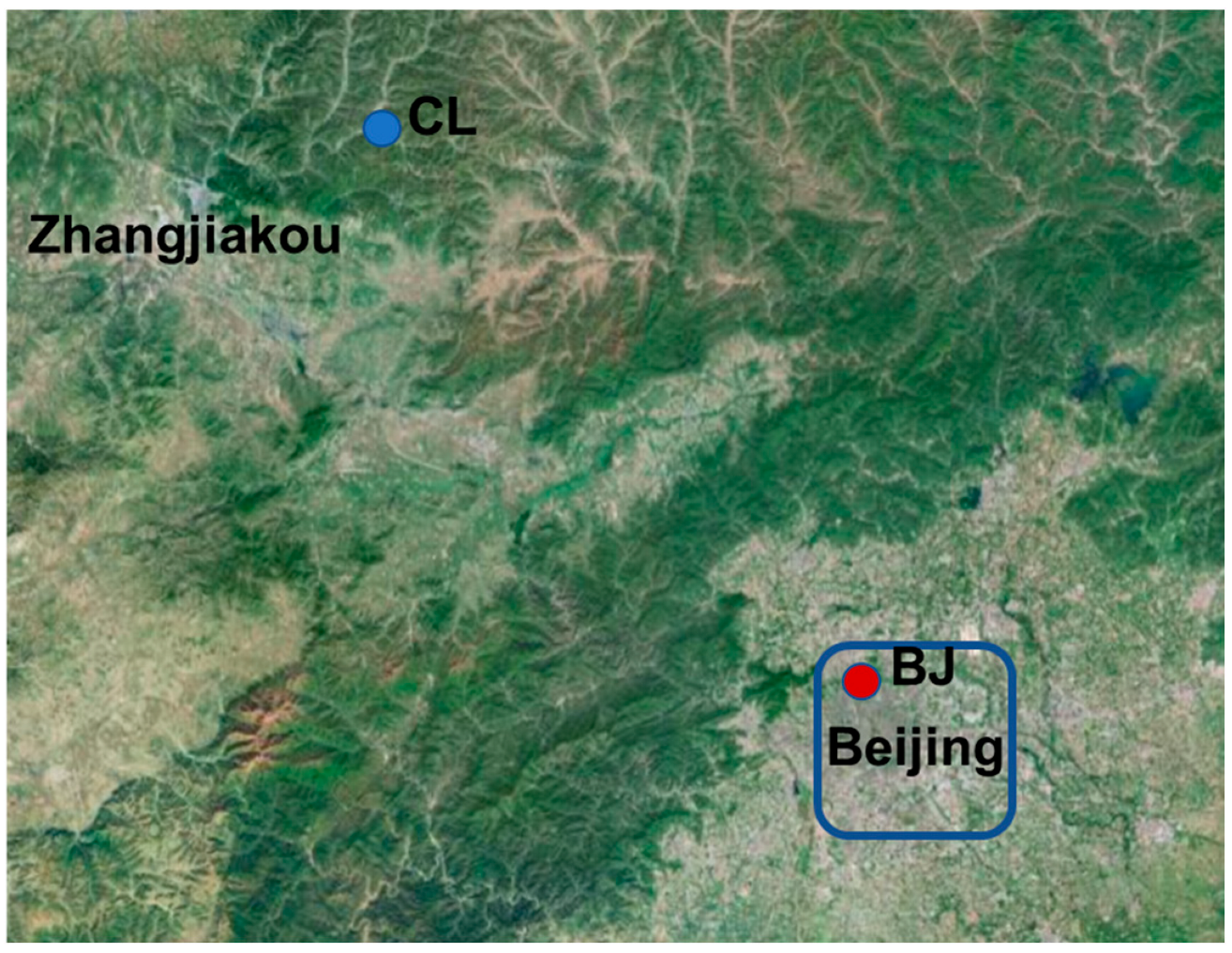
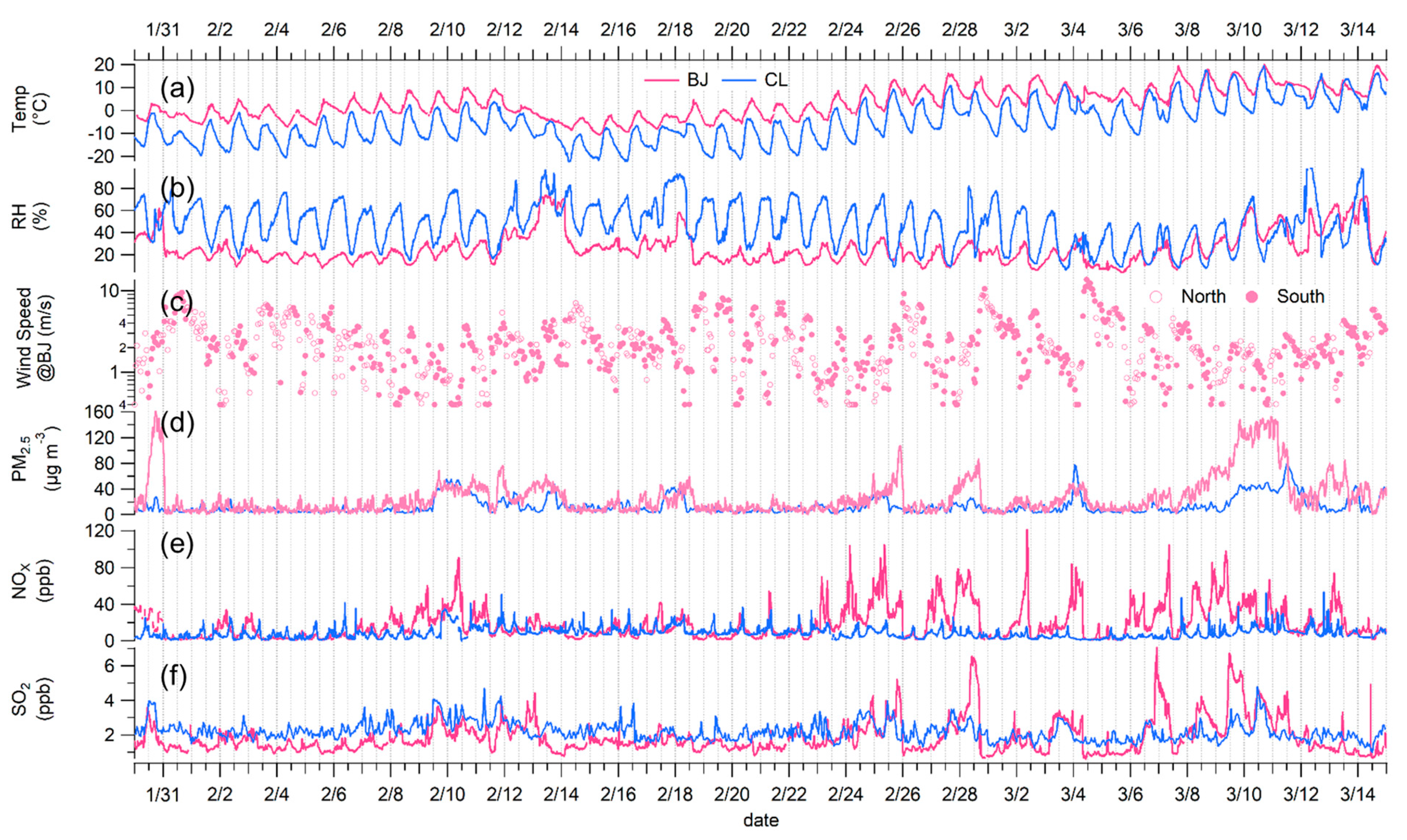
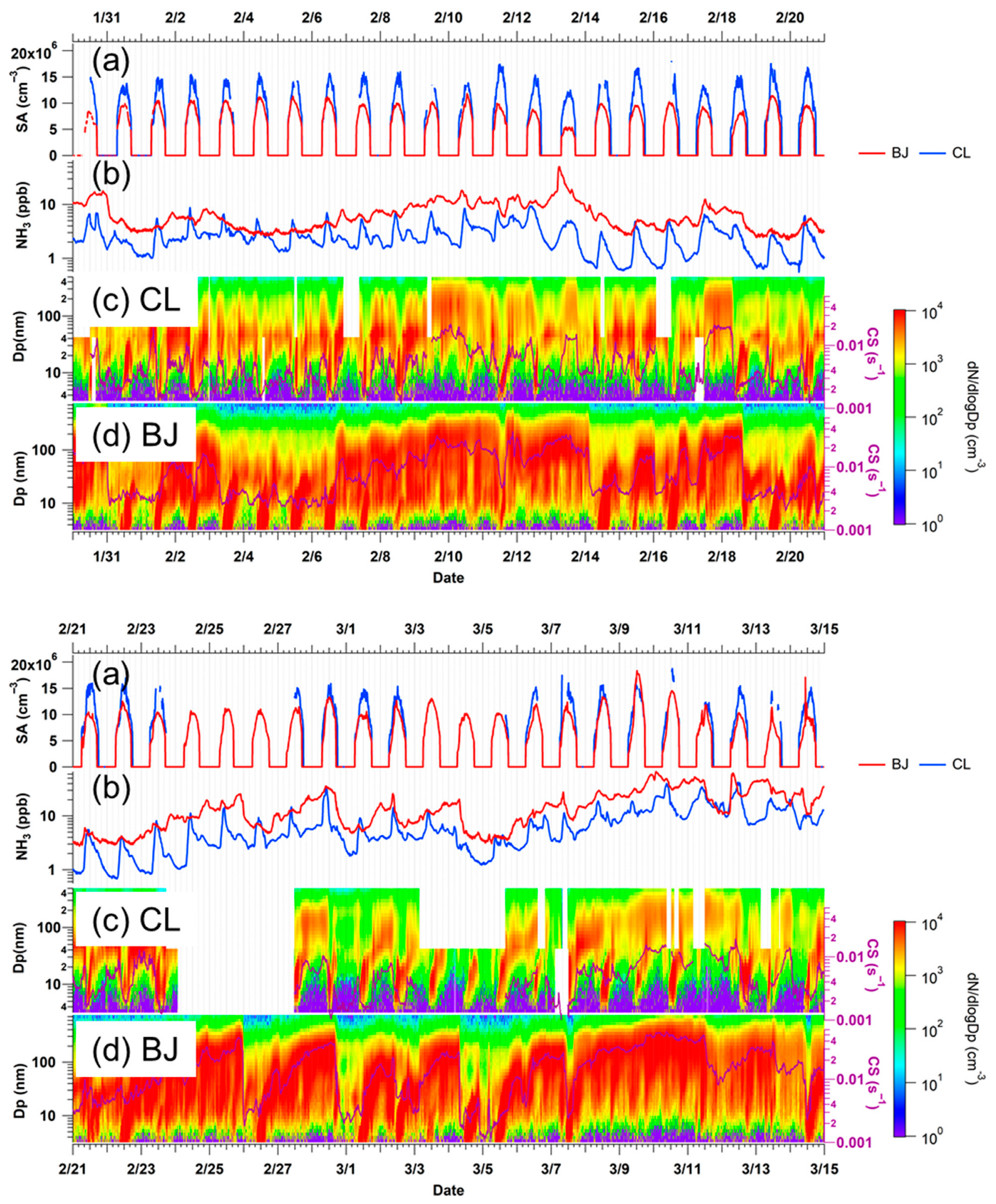
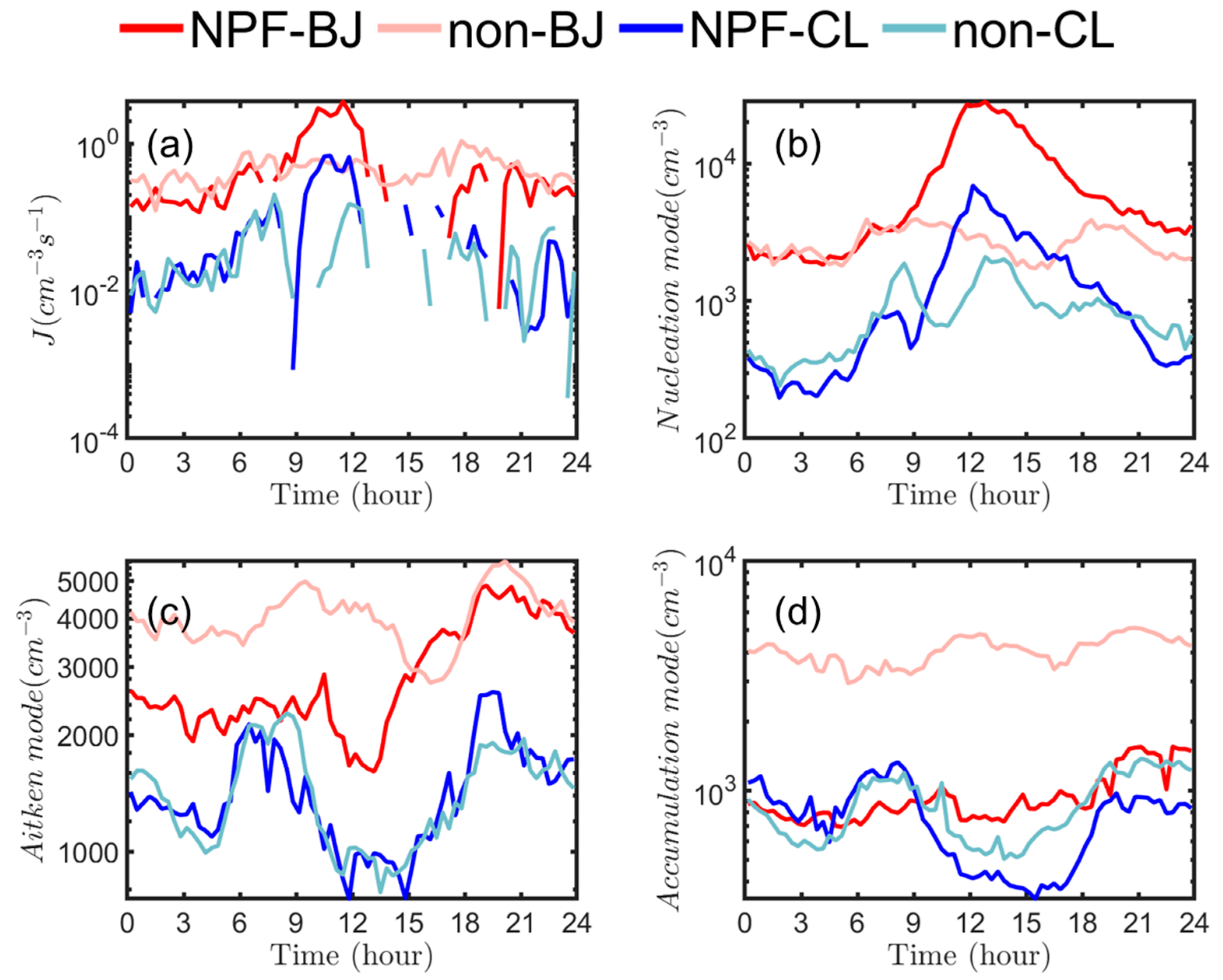
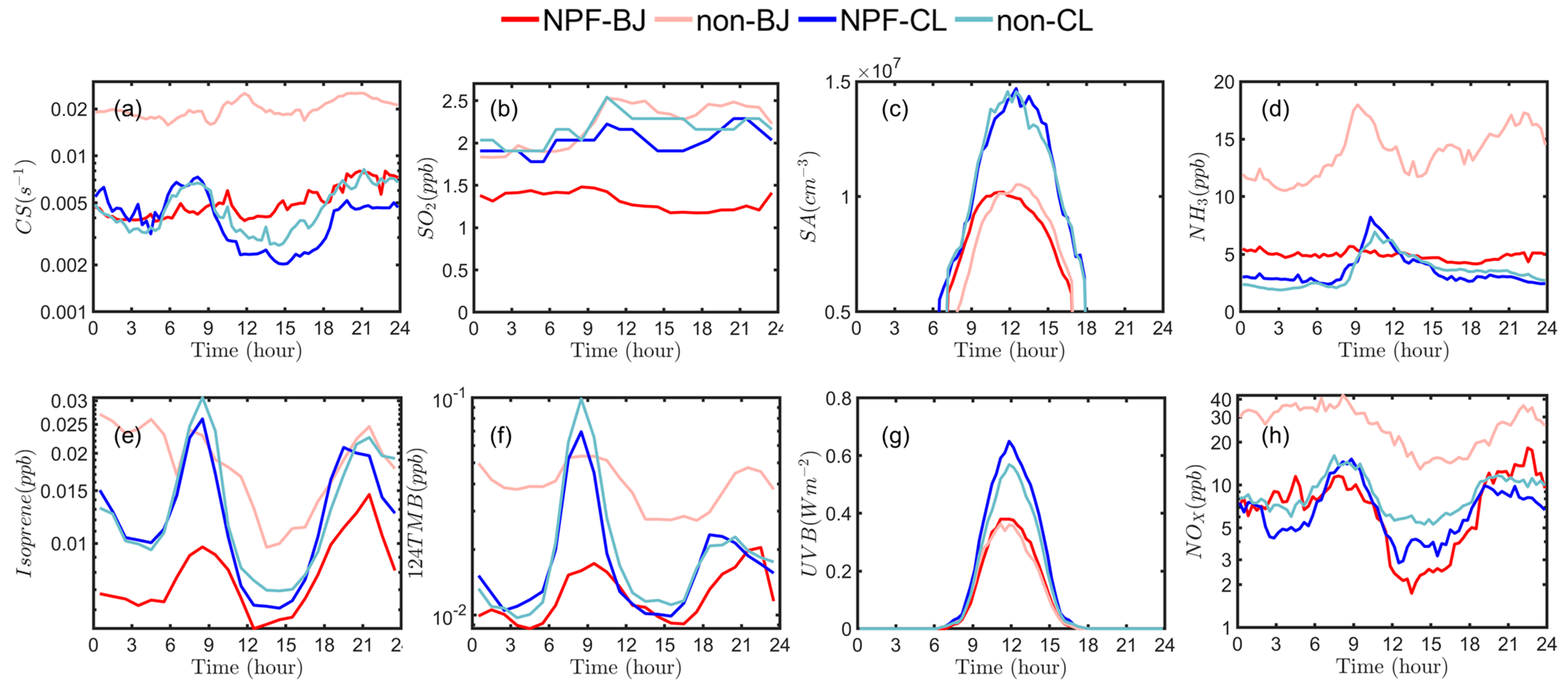


Disclaimer/Publisher’s Note: The statements, opinions and data contained in all publications are solely those of the individual author(s) and contributor(s) and not of MDPI and/or the editor(s). MDPI and/or the editor(s) disclaim responsibility for any injury to people or property resulting from any ideas, methods, instructions or products referred to in the content. |
© 2023 by the authors. Licensee MDPI, Basel, Switzerland. This article is an open access article distributed under the terms and conditions of the Creative Commons Attribution (CC BY) license (https://creativecommons.org/licenses/by/4.0/).
Share and Cite
Shang, D.; Hu, M.; Wang, X.; Tang, L.; Clusius, P.S.; Qiu, Y.; Yu, X.; Chen, Z.; Zhang, Z.; Sun, J.; et al. Spatial Inhomogeneity of New Particle Formation in the Urban and Mountainous Atmospheres of the North China Plain during the 2022 Winter Olympics. Atmosphere 2023, 14, 1395. https://doi.org/10.3390/atmos14091395
Shang D, Hu M, Wang X, Tang L, Clusius PS, Qiu Y, Yu X, Chen Z, Zhang Z, Sun J, et al. Spatial Inhomogeneity of New Particle Formation in the Urban and Mountainous Atmospheres of the North China Plain during the 2022 Winter Olympics. Atmosphere. 2023; 14(9):1395. https://doi.org/10.3390/atmos14091395
Chicago/Turabian StyleShang, Dongjie, Min Hu, Xiaoyan Wang, Lizi Tang, Petri S. Clusius, Yanting Qiu, Xuena Yu, Zheng Chen, Zirui Zhang, Jiaqi Sun, and et al. 2023. "Spatial Inhomogeneity of New Particle Formation in the Urban and Mountainous Atmospheres of the North China Plain during the 2022 Winter Olympics" Atmosphere 14, no. 9: 1395. https://doi.org/10.3390/atmos14091395
APA StyleShang, D., Hu, M., Wang, X., Tang, L., Clusius, P. S., Qiu, Y., Yu, X., Chen, Z., Zhang, Z., Sun, J., Dao, X., Zeng, L., Guo, S., Wu, Z., & Boy, M. (2023). Spatial Inhomogeneity of New Particle Formation in the Urban and Mountainous Atmospheres of the North China Plain during the 2022 Winter Olympics. Atmosphere, 14(9), 1395. https://doi.org/10.3390/atmos14091395








